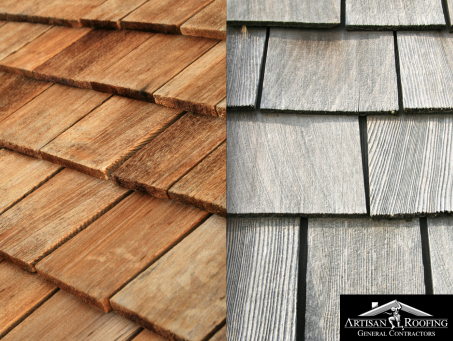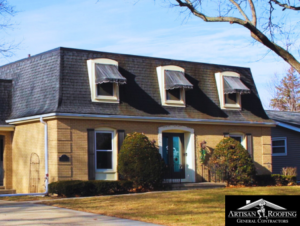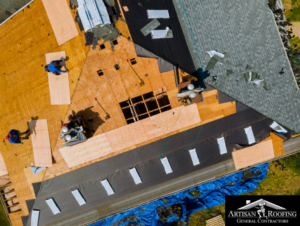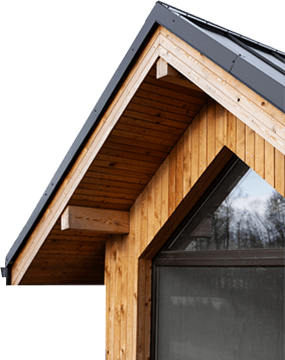For homeowners seeking a rustic, elegant look that stands out, cedar shake roofing offers a timeless appeal that adds character and charm to any home. Traditionally crafted from large cedar trees, natural cedar shakes have long been appreciated for their natural beauty and durability. However, as technology advances, synthetic cedar shakes are emerging as a viable alternative, promising the aesthetic appeal of real wood with enhanced durability and lower maintenance.
Choosing the right material involves understanding both options in terms of lifespan, durability, aesthetics, environmental impact, and cost.
This in-depth guide will walk you through the key considerations when deciding between natural and synthetic cedar shake roofing to help you select the best option for your home.
What Is Cedar Shake Roofing?
Cedar shake roofs have been a part of architectural design for centuries, bringing an element of natural beauty and a unique texture to homes.
Made from split logs of cedar wood, often sourced from the forests of the Pacific Northwest, natural cedar shakes are either hand-split or sawn to give them their rugged look. This gives each piece a slightly different texture, which adds depth and character to the overall roof.
Apart from the aesthetic appeal, cedar shakes offer natural insulation properties that help regulate indoor temperatures, keeping homes warmer in winter and cooler in summer. With proper maintenance, these roofs can last up to 30 years, though climate and upkeep heavily influence their longevity.
Synthetic Cedar Shake Roofing: A Modern Twist on Tradition
Synthetic cedar shake roofing, often referred to as composite shake roofing, is designed to replicate the beauty of natural cedar without the challenges associated with wood.
Manufactured from high-quality polymers, recycled materials, or a blend of both, synthetic shakes offer superior durability and are specifically engineered to resist issues like rot, insects, and warping.
Synthetic cedar shakes can last up to 50 years, making them an attractive option for homeowners looking for a longer-lasting solution with less upkeep.
Available in various styles and colors, synthetic shakes can closely mimic the appearance of real wood, offering homeowners the charm of cedar with enhanced durability.
Lifespan & Durability: How Do They Compare?
Durability and longevity are major factors when investing in a roof. Here’s how natural and synthetic cedar shake roofs hold up over time.
Natural Cedar Shake Roof
With regular maintenance, a natural cedar shake roof typically lasts between 25 and 30 years. However, its durability is highly dependent on climate and maintenance.
In areas with high humidity, cedar is susceptible to moisture retention, which can lead to mold, mildew, and rot. In drier climates, cedar may dry out and crack, becoming brittle over time.
Regular treatments, such as sealing and cleaning, are essential for prolonging the lifespan of natural cedar shakes. Although it requires more upkeep, natural cedar appeals to those who appreciate a roof that ages gracefully, transforming from warm hues to a soft, silvery-gray patina over time.
Synthetic Cedar Shake Roof
Synthetic cedar shakes are built to withstand harsh weather conditions, including heavy rain, high winds, and intense UV exposure. Unlike natural wood, synthetic materials are resistant to moisture and insects, making them ideal for climates where traditional cedar would struggle. These synthetic roofs are often rated to last 40 to 50 years, providing a long-lasting solution for homeowners.
With minimal maintenance requirements and resistance to common issues like rot, mold, and warping, synthetic cedar shakes offer a durable, low-maintenance option that can handle extreme weather while maintaining their appearance.
Appearance Over Time: The Natural vs. Synthetic Look
The look of a roof can dramatically impact a home’s curb appeal. Both natural and synthetic cedar shakes offer unique aesthetics, but they differ in how they age and hold up visually over time.
Natural Cedar Shake Roof
When new, cedar shakes have a warm, reddish-brown color that naturally fades to a silvery-gray as the wood weathers. This aging process is beloved by many homeowners who appreciate the evolving patina and natural character of cedar.
However, if not maintained, natural cedar can develop cracks, curling, or mold growth, which may affect its appearance.
Synthetic Cedar Shake Roof
Synthetic cedar shakes are designed to retain their color and shape for decades, ensuring a consistent look. Available in a range of colors and styles, synthetic shakes replicate the grain and texture of real cedar while providing a uniform, polished appearance that doesn’t change much over time.
For homeowners who prefer a stable, long-lasting aesthetic without natural weathering, synthetic cedar shakes are a great choice.
Environmental Impact: Sustainability Considerations
As homeowners become more eco-conscious, the sustainability of building materials, including roofing, has become an important consideration.
Natural Cedar Shake Roof
Natural cedar is a renewable resource, and the shakes are biodegradable, making them eco-friendly in some respects. However, the environmental impact of natural cedar roofing is complex.
Harvesting cedar wood contributes to deforestation, especially since old-growth trees are typically preferred for their quality. Additionally, treatments used to preserve cedar shakes may introduce chemicals into the environment, potentially affecting soil and water quality.
Synthetic Cedar Shake Roof
Synthetic cedar shakes are often made from recycled materials, reducing waste and the demand for new resources. Although synthetic materials aren’t biodegradable, the long lifespan of synthetic shakes means fewer replacements over time, leading to less waste overall.
Many manufacturers use eco-friendly practices to produce synthetic shakes, making them a more sustainable choice for environmentally conscious homeowners.
Maintenance: How Much Upkeep Is Involved?
The level of maintenance required for each type of cedar shake roofing can have a significant impact on both your time and budget.
Natural Cedar Shake Roof
Natural cedar shake roofs require consistent maintenance to protect against moisture, mold, and insect damage. Homeowners need to regularly clean debris from the roof, apply wood preservatives, and replace any damaged or warped shakes. Without proper maintenance, natural cedar can deteriorate rapidly, compromising the roof’s structural integrity.
While the upkeep can be time-consuming and costly, regular maintenance can extend the life of a natural cedar roof. For homeowners willing to invest the time and effort, the natural beauty of cedar can be worth it.
Synthetic Cedar Shake Roof
One of the primary advantages of synthetic cedar shakes is their low maintenance. Unlike natural wood, synthetic materials resist mold, rot, and insect infestations, so they don’t require regular treatments or repairs. Occasional inspections and cleaning are usually sufficient to keep a synthetic cedar shake roof in good shape.
This low-maintenance quality makes synthetic cedar shakes an attractive option for homeowners who want the look of cedar without the hassle of ongoing upkeep.
Cost Comparison: What Fits Your Budget?
Cost is a crucial factor in choosing a roofing material, especially since both natural and synthetic cedar shakes are premium options.
Natural Cedar Shake Roof
The cost of natural cedar shakes typically ranges from $25 to $30 per square foot, though prices can vary based on the quality of the wood, installation complexity, and location. While the initial investment may be higher, the aesthetic appeal and insulation benefits of natural cedar can add value to your home.
However, the ongoing maintenance and shorter lifespan may lead to higher costs over time. Routine treatments, repairs, and potential replacements all add up, making natural cedar a pricier option in the long run.
Synthetic Cedar Shake Roof
Synthetic cedar shakes generally cost between $14 and $18 per square foot, making them a more budget-friendly choice upfront. In addition to the lower initial cost, the reduced maintenance and extended lifespan of synthetic shakes make them an economical choice over time.
With fewer repairs and replacements needed, synthetic cedar shakes provide excellent value for homeowners seeking durability and longevity.
Choosing the Right Cedar Shake Roof for Your Home
With a thorough understanding of each option, you’re better equipped to decide which cedar shake roof is right for you. Here’s a quick guide to help:
-
Opt for Natural Cedar Shakes if:
-
-
- You love the authentic look and feel of real wood.
- You’re comfortable with regular maintenance and upkeep.
- You live in a moderate climate where the wood won’t experience extreme wear.
-
-
Opt for Synthetic Cedar Shakes if:
-
- You prefer a low-maintenance, long-lasting solution.
- You want a consistent look that won’t change over time.
- You’re seeking a more budget-friendly option that still offers aesthetic appeal.
Both natural and synthetic cedar shakes have unique benefits. Natural cedar provides a timeless, evolving look with warm tones and organic texture, while synthetic cedar combines beauty with modern durability and convenience.
Final Thoughts: Natural Beauty vs. Modern Convenience
In the end, both natural and synthetic cedar shake roofs can enhance the appearance of your home while providing protection from the elements. The choice comes down to personal preference, budget, and willingness to maintain the roof over time.
For homeowners who appreciate the classic charm of weathered wood and are prepared for ongoing maintenance, natural cedar shakes offer unmatched beauty. For those looking for a durable, low-maintenance option that still provides the aesthetic of wood, synthetic cedar shakes are an excellent choice.
If you’re ready to explore your options further, reach out to Artisan Roofing today. Our team of experts can guide both natural and synthetic cedar shake roofing, helping you find the perfect solution for your home.






